外研版(2019)选择性必修第二册Unit 2 Improving you Developing ideas and presenting ideas 课件PPT(共23张)
文档属性
| 名称 | 外研版(2019)选择性必修第二册Unit 2 Improving you Developing ideas and presenting ideas 课件PPT(共23张) | 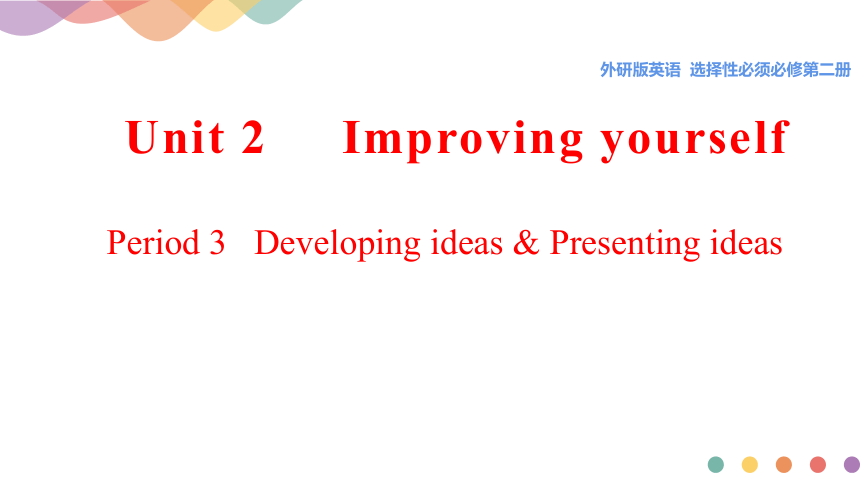 | |
| 格式 | zip | ||
| 文件大小 | 50.5MB | ||
| 资源类型 | 教案 | ||
| 版本资源 | 外研版(2019) | ||
| 科目 | 英语 | ||
| 更新时间 | 2022-08-28 14:40:15 | ||
图片预览

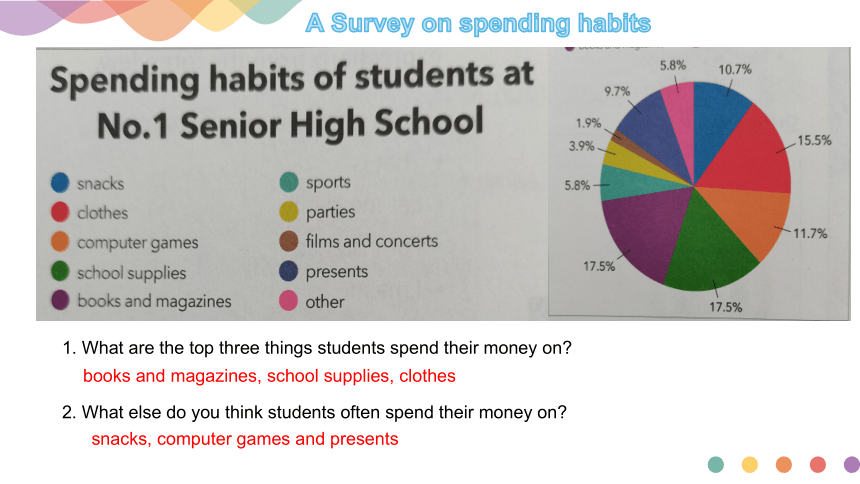
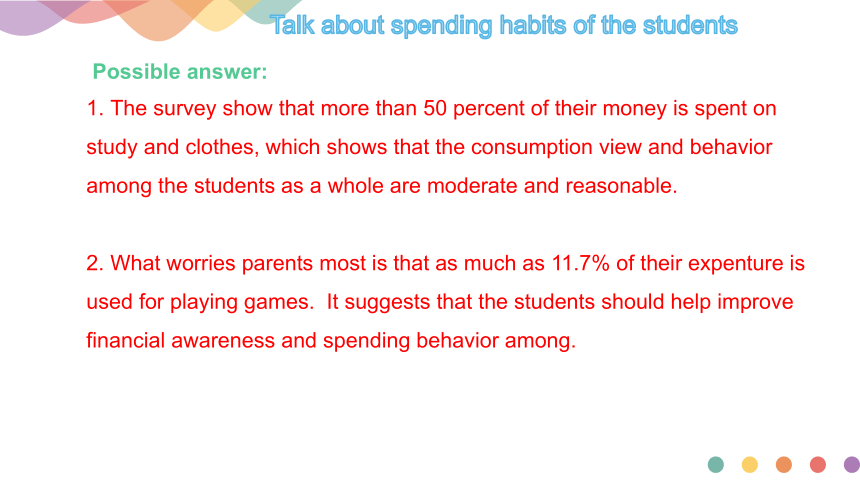
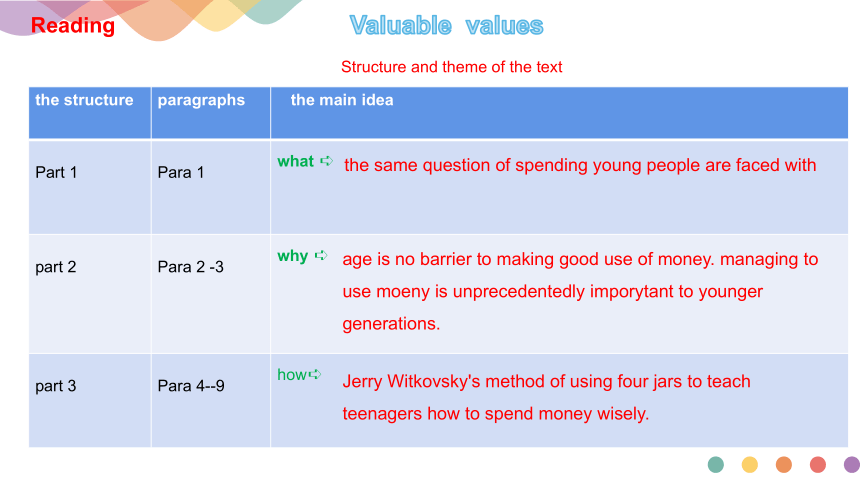
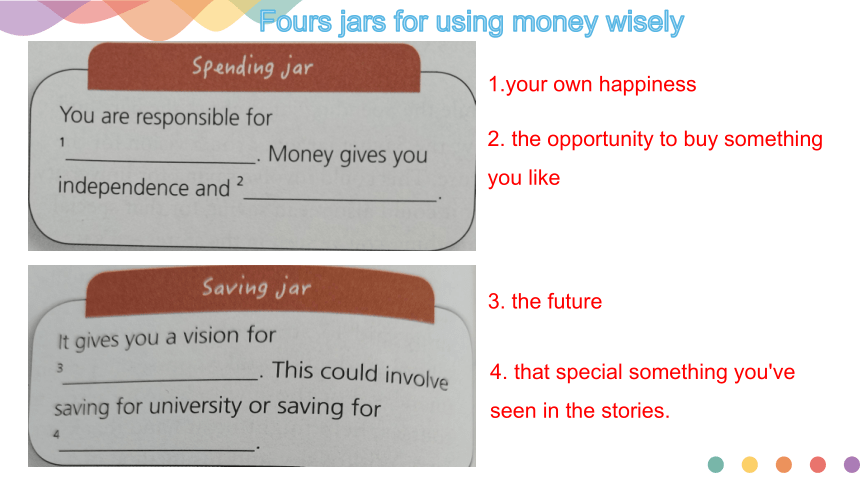

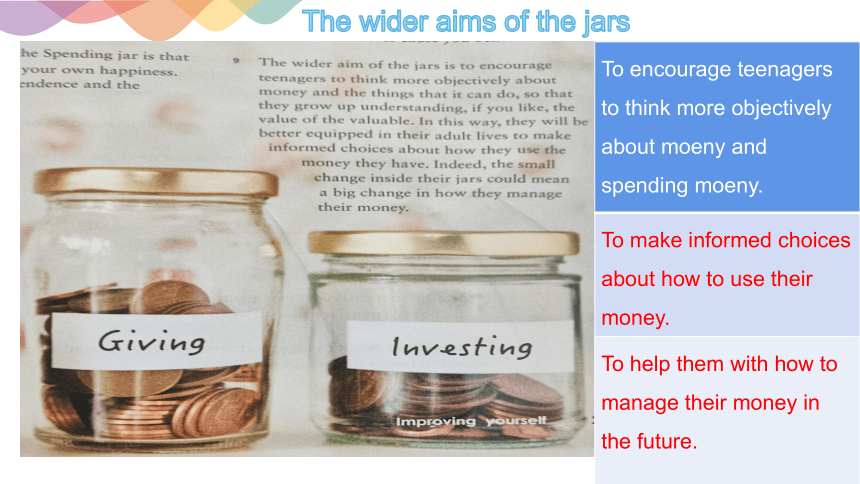
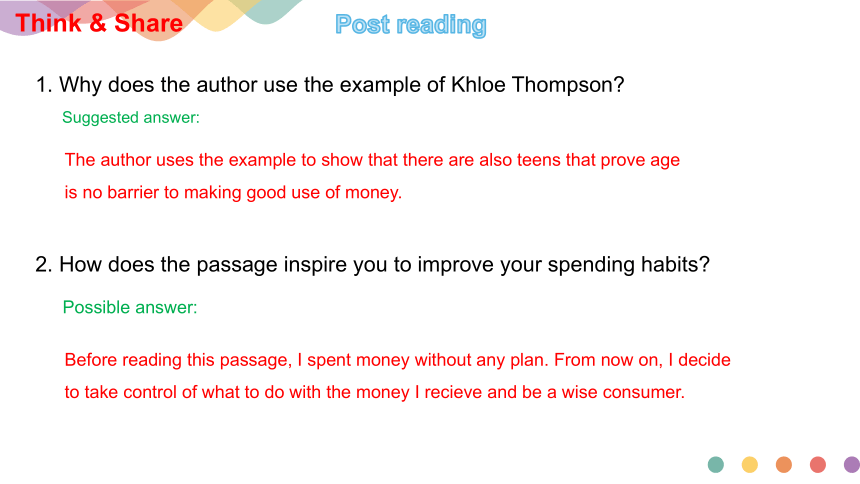

文档简介
(共23张PPT)
Unit 2 Improving yourself
Period 3 Developing ideas & Presenting ideas
外研版英语 选择性必须必修第二册
A Survey on spending habits
1. What are the top three things students spend their money on
2. What else do you think students often spend their money on
books and magazines, school supplies, clothes
snacks, computer games and presents
Possible answer:
1. The survey show that more than 50 percent of their money is spent on study and clothes, which shows that the consumption view and behavior among the students as a whole are moderate and reasonable.
2. What worries parents most is that as much as 11.7% of their expenture is used for playing games. It suggests that the students should help improve financial awareness and spending behavior among.
Talk about spending habits of the students
Reading
Valuable values
Structure and theme of the text
the structure paragraphs the main idea
Part 1 Para 1 what
part 2 Para 2 -3 why
part 3 Para 4--9 how
the same question of spending young people are faced with
age is no barrier to making good use of money. managing to use moeny is unprecedentedly imporytant to younger generations.
Jerry Witkovsky's method of using four jars to teach teenagers how to spend money wisely.
Fours jars for using money wisely
1.your own happiness
2. the opportunity to buy something you like
3. the future
4. that special something you've seen in the stories.
Fours jars for using money wisely
5. build for the future
6. investing in yourself
7. kindness and helping
8. whatever cause you believe in
The wider aims of the jars
To encourage teenagers to think more objectively about moeny and spending moeny.
To make informed choices about how to use their money.
To help them with how to manage their money in the future.
Think & Share
Post reading
1. Why does the author use the example of Khloe Thompson
Suggested answer:
2. How does the passage inspire you to improve your spending habits
Possible answer:
The author uses the example to show that there are also teens that prove age is no barrier to making good use of money.
Before reading this passage, I spent money without any plan. From now on, I decide to take control of what to do with the money I recieve and be a wise consumer.
Think & Share
Post reading
3. If you were given 1000 yuan, how much money would you put in each jar
Possible answer:
I will put half of it in the saving jar, 200 yuan in the investing jar, 200 yunan in the spending jar, and 100 yuan in the giving jar. I must save a lot of money for my future, including the fee for education. I need to invest myself, such as buying online courses and going to gym. Besides, I need money to buy books, pay phone bills and so on. I also indend to show concerns for those in need, so I will put aside some money to give others in need.
Think & Share
Post reading
4. What methods of self-management have you learned in the reading passage What else do you need to improve
Suggested answer:
Jerry Witkovsky used four jars to teach teenagers how to spend their money wisely. He taught the teenagers valuable values through common things in life and passed the good values down to the next generation.
Talk about the values represented by the four jars
The most important jar you believe: Reasons:
Supporting examples:
the Investing jar
It can help spend, save and give.
1. It represents a vision for the future.
2. It invests in yourself.
Before writing
Read the story and answer the questions.
1. What aspect of self-management is the passage about
2. What message do you think the story convey
Suggested anwer: Controlling one's temper.
Suggested anwer:
As far as I'm concerned, you can control your temper so long as you try. What's more, the words you say in anger will definitely hurt others' feelings, no matter what you do after that to make up for your mistakes.
Smmary of the story
Summary of the story:
My thoughts:
Conclusion:
A father teaches his son how to control his temper by hammering nails into fence and pulling them out. The father also makes his son understand that the words that he said in anger will leave a hole in someone's heart.
The father is wise enough to teach his son a lesson using such an unforgetable way.
Think twice before action and learn to control our emotions, which will be good to us and those around us.
Presenting ideas
Quotes & Meanings
a The superior man must be watchful over himself when he is alone.
b Procrastination is like a credit card: it's a lot of fun until you get the bill.
It means that one makes morals a true code of conduct from the heart by cultivating one's morality.
It means that while the problem caused by procrastination may not be immediately apparent, they will eventually occur and the procrastinator will pay the price.
Presenting ideas
Quotes & Meanin
c No man is free who is not master of himself.
d Change your thoughts, and you change the world.
A person should learn self-management. Only in this way can we a person have real freedom.
A person's thoughts determine his actions and direction. Thoughts determine the course of life.
Presenting ideas
Quotes & Meani
e Don't say you don't have enough time. You have exactly the same number of hours per day that were given to Helen Keller, Pasteur, Michelangelo,...Lenardo da Vinci, Thomas Jefferson, and Albert Eistein.
Everyone has the same amount of time. Some people succeed not because they have more time than you, but because they can manage their time well.
Prepare a short presentation about the quote.
The quote: “Your future depends on many things but mostly on you.”
I can't agree more with this view. It's true that our future is determined by many things, such as opportunities and help from others,but our own attitude, determination and diligence play a more important role. In other words, we are the master of our own future.
Take Abraham Lincoln for example, he was born in a poor family and received a limited education in his childhood, yet through his effort, he changed not onlyhis own fate,but also the history of America. Therefore, I firmly believe that our future depends on mostly ourselves.
Language appreciation
1. Inside the bags are necessities such as toothpaste, soap and socks, bought first with her pocket money and ...
[句式分析] “Inside the bags are necessities ”采用完全倒装句结构,即“介词短语+系动词+主语”;“bought first with her pocket money and ... ”为过去分词短语充当后置定语,相当于定语从句“ which are bought first with ...”
[尝试翻译] 包里是必需品,如牙膏,肥皂和袜子,这些先用她的零花钱买的...
Language appreciation
2. It was from then on that his grandchildren started to be in control of what to do with the money they receive: spend, save, invest and give
[句式分析] “It was from then on that... ”采用强调句结构“It's +被强调成分+ that-clause”, 这里强调的是“时间状语 from then on”; “what to do with...”为 “特殊疑问词+不定式”结构,相当于名词短语,在句中作of 的宾语; “they receive”为定语从句修饰先行词“the money”.
[尝试翻译] 从那时起,他的孙子们开始管理如何使用他们收到的钱:是花、存、投资还是捐赠?
Language appreciation
3. Whether you want to help out a friend, give money to an animal charity or to children in another country, it's your money to give to whatever cause you believe in.
[句式分析] “Whether... or...”:无论是...还是..., 引导让步状语从句,完整表达为 “No matter whether... or...”; “whatever cause +主语+谓语”既可以引导让步状语从句,也可以引导名词性从句,这里做介词to的宾语;此外,本语境中采用了省略形式, 完整形式为:what cause (you believe in --定语从句) it is.
[尝试翻译] 不管你是想帮助朋友,还是想把钱捐给动物慈善机构,还是捐给其他国家的孩子,你的钱都可以捐给你所信仰的任何事业。
Assignments for this period
1. Review the vocabulary and the language ponits of the text.
2. Choose one quote you like and make notes the meaning of it.
3. Write a reflection according to a story of a philosophy.
感谢您的观看
Unit 2 Improving yourself
Period 3 Developing ideas & Presenting ideas
外研版英语 选择性必须必修第二册
A Survey on spending habits
1. What are the top three things students spend their money on
2. What else do you think students often spend their money on
books and magazines, school supplies, clothes
snacks, computer games and presents
Possible answer:
1. The survey show that more than 50 percent of their money is spent on study and clothes, which shows that the consumption view and behavior among the students as a whole are moderate and reasonable.
2. What worries parents most is that as much as 11.7% of their expenture is used for playing games. It suggests that the students should help improve financial awareness and spending behavior among.
Talk about spending habits of the students
Reading
Valuable values
Structure and theme of the text
the structure paragraphs the main idea
Part 1 Para 1 what
part 2 Para 2 -3 why
part 3 Para 4--9 how
the same question of spending young people are faced with
age is no barrier to making good use of money. managing to use moeny is unprecedentedly imporytant to younger generations.
Jerry Witkovsky's method of using four jars to teach teenagers how to spend money wisely.
Fours jars for using money wisely
1.your own happiness
2. the opportunity to buy something you like
3. the future
4. that special something you've seen in the stories.
Fours jars for using money wisely
5. build for the future
6. investing in yourself
7. kindness and helping
8. whatever cause you believe in
The wider aims of the jars
To encourage teenagers to think more objectively about moeny and spending moeny.
To make informed choices about how to use their money.
To help them with how to manage their money in the future.
Think & Share
Post reading
1. Why does the author use the example of Khloe Thompson
Suggested answer:
2. How does the passage inspire you to improve your spending habits
Possible answer:
The author uses the example to show that there are also teens that prove age is no barrier to making good use of money.
Before reading this passage, I spent money without any plan. From now on, I decide to take control of what to do with the money I recieve and be a wise consumer.
Think & Share
Post reading
3. If you were given 1000 yuan, how much money would you put in each jar
Possible answer:
I will put half of it in the saving jar, 200 yuan in the investing jar, 200 yunan in the spending jar, and 100 yuan in the giving jar. I must save a lot of money for my future, including the fee for education. I need to invest myself, such as buying online courses and going to gym. Besides, I need money to buy books, pay phone bills and so on. I also indend to show concerns for those in need, so I will put aside some money to give others in need.
Think & Share
Post reading
4. What methods of self-management have you learned in the reading passage What else do you need to improve
Suggested answer:
Jerry Witkovsky used four jars to teach teenagers how to spend their money wisely. He taught the teenagers valuable values through common things in life and passed the good values down to the next generation.
Talk about the values represented by the four jars
The most important jar you believe: Reasons:
Supporting examples:
the Investing jar
It can help spend, save and give.
1. It represents a vision for the future.
2. It invests in yourself.
Before writing
Read the story and answer the questions.
1. What aspect of self-management is the passage about
2. What message do you think the story convey
Suggested anwer: Controlling one's temper.
Suggested anwer:
As far as I'm concerned, you can control your temper so long as you try. What's more, the words you say in anger will definitely hurt others' feelings, no matter what you do after that to make up for your mistakes.
Smmary of the story
Summary of the story:
My thoughts:
Conclusion:
A father teaches his son how to control his temper by hammering nails into fence and pulling them out. The father also makes his son understand that the words that he said in anger will leave a hole in someone's heart.
The father is wise enough to teach his son a lesson using such an unforgetable way.
Think twice before action and learn to control our emotions, which will be good to us and those around us.
Presenting ideas
Quotes & Meanings
a The superior man must be watchful over himself when he is alone.
b Procrastination is like a credit card: it's a lot of fun until you get the bill.
It means that one makes morals a true code of conduct from the heart by cultivating one's morality.
It means that while the problem caused by procrastination may not be immediately apparent, they will eventually occur and the procrastinator will pay the price.
Presenting ideas
Quotes & Meanin
c No man is free who is not master of himself.
d Change your thoughts, and you change the world.
A person should learn self-management. Only in this way can we a person have real freedom.
A person's thoughts determine his actions and direction. Thoughts determine the course of life.
Presenting ideas
Quotes & Meani
e Don't say you don't have enough time. You have exactly the same number of hours per day that were given to Helen Keller, Pasteur, Michelangelo,...Lenardo da Vinci, Thomas Jefferson, and Albert Eistein.
Everyone has the same amount of time. Some people succeed not because they have more time than you, but because they can manage their time well.
Prepare a short presentation about the quote.
The quote: “Your future depends on many things but mostly on you.”
I can't agree more with this view. It's true that our future is determined by many things, such as opportunities and help from others,but our own attitude, determination and diligence play a more important role. In other words, we are the master of our own future.
Take Abraham Lincoln for example, he was born in a poor family and received a limited education in his childhood, yet through his effort, he changed not onlyhis own fate,but also the history of America. Therefore, I firmly believe that our future depends on mostly ourselves.
Language appreciation
1. Inside the bags are necessities such as toothpaste, soap and socks, bought first with her pocket money and ...
[句式分析] “Inside the bags are necessities ”采用完全倒装句结构,即“介词短语+系动词+主语”;“bought first with her pocket money and ... ”为过去分词短语充当后置定语,相当于定语从句“ which are bought first with ...”
[尝试翻译] 包里是必需品,如牙膏,肥皂和袜子,这些先用她的零花钱买的...
Language appreciation
2. It was from then on that his grandchildren started to be in control of what to do with the money they receive: spend, save, invest and give
[句式分析] “It was from then on that... ”采用强调句结构“It's +被强调成分+ that-clause”, 这里强调的是“时间状语 from then on”; “what to do with...”为 “特殊疑问词+不定式”结构,相当于名词短语,在句中作of 的宾语; “they receive”为定语从句修饰先行词“the money”.
[尝试翻译] 从那时起,他的孙子们开始管理如何使用他们收到的钱:是花、存、投资还是捐赠?
Language appreciation
3. Whether you want to help out a friend, give money to an animal charity or to children in another country, it's your money to give to whatever cause you believe in.
[句式分析] “Whether... or...”:无论是...还是..., 引导让步状语从句,完整表达为 “No matter whether... or...”; “whatever cause +主语+谓语”既可以引导让步状语从句,也可以引导名词性从句,这里做介词to的宾语;此外,本语境中采用了省略形式, 完整形式为:what cause (you believe in --定语从句) it is.
[尝试翻译] 不管你是想帮助朋友,还是想把钱捐给动物慈善机构,还是捐给其他国家的孩子,你的钱都可以捐给你所信仰的任何事业。
Assignments for this period
1. Review the vocabulary and the language ponits of the text.
2. Choose one quote you like and make notes the meaning of it.
3. Write a reflection according to a story of a philosophy.
感谢您的观看
